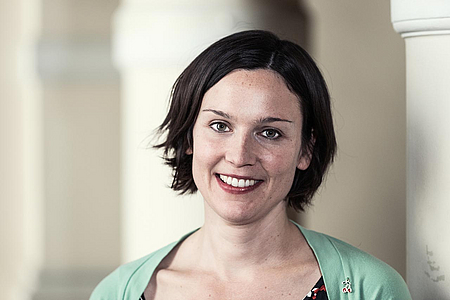The brain as unknown territory
Dr. Schmack, what do you research?
My research field is schizophrenia. This is an illness that one can treat with medications and psychotherapy, but often with only limited success and not always with lasting effects. On top of that, we still have no comprehensive explanation for how the symptoms of schizophrenia arise. In schizophrenia, patients experience a change in their perceptions and suffer from hallucinations and delusions. Time and again, I sit in front of patients who are suffering. But I can’t answer their question as to what’s happening in their brain. One of the few things that we know about schizophrenia relates to the neurotransmitter dopamine: too much of it is released in the brain. We know that because medications that are effective against the symptoms of schizophrenia block this neurotransmitter in the brain, leading to a decrease in the symptoms. However, how exactly dopamine can change perception in schizophrenia and what role it plays in normal perception is not yet understood. My goal is to find out more precise.
What is your approach here?
Using magnetic resonance tomography (MRI) it’s possible to image the blood flow in the brain and to determine where neurons are currently active. So, we use functional MRIs and give the patients tasks while they’re lying in the tube. This makes it possible to see which region of the brain is activated during these tasks. Our research is thereby conducted on several levels. First, we study patients with schizophrenia, compare them with a healthy control group and thus try to find out how these people perceive the world and which areas of the brain thereby play a role. We quantify this with the help of mathematical models. In addition, we carry out an experiment in which we give healthy test subjects L-DOPA – a substance that leads to the formation of increased dopamine in the brain. We observe whether there’s any change in perception and the brain activation pattern. Incidentally, this procedure is low-risk for the test subjects.
What exactly does the procedure involve?
For example, in one experiment that we’re currently working on, the test subjects lie down in the MRI and at the same time look at a random “foggy” picture. Almost all people occasionally discern a face in such foggy pictures. We see the same phenomenon with clouds, which remind us of certain objects or people. Interestingly, patients with schizophrenia see more faces in such foggy pictures than healthy people do. We check whether and how this is connected with dopamine. We also test whether after taking L-DOPA, the test subjects see more faces than after taking a placebo, and which areas of the brain are thereby activated.
What is the greatest challenge in doing this research?
The greatest difficulty in principle is that the topic is researched on humans. Thus one can examine only limited causal connections and make frequently only correlative observations. Also, for ethical reasons patients with schizophrenia are quickly given mediation to mitigate their symptoms. However, under observation this blurs the distinction between the effects of the illness and any effects of the treatment.

Funding program
BIH Charité Clinician Scientists
Funding period
2015 – 2018
Project title
The neurobiology of delusions: linking perceptual inference and dopamine
Research areas
Psychiatry, neuroscience
Institution
Charité – Universitätsmedizin Berlin
Since 2018
Leopoldina scholarship holder and Research Fellow at Cold Spring Harbor Laboratory, New York, USA
2009 – 2018
Research assistant and Resident Physician, Department of Psychiatry and Psychotherapy, Charité – Universitätsmedizin Berlin
2009
PhD thesis on „Genetic and pharmacological influences on dopaminergic processes in the brain in patients with schizophrenia and healthy test subjects – three fMRI trials“ (summa cum laude), Charité – Universitätsmedizin Berlin
Where does your fascination for this subject come from?
I find the brain the most interesting organ of all. There’s still a great deal to research, particularly in the area of psychiatry. In the long term, I’d really like to see psychiatry being in a position to make quasi-mechanistic diagnoses and to offer causal therapies, just like other areas of medicine. At the moment, many diagnoses are made on the basis of symptom checklists, because we have no understanding of which mechanism underlies a specific illness. Once we’ve made a diagnosis, we then only treat the symptoms again – sometimes with limited success. I’d like to see us gain a better understanding of the underlying causes. I’m also convinced that stigmas attached to illnesses, and there’s no question that this applies to schizophrenia, have a lot to do with the fact that one doesn’t understand an illness and can’t treat it in a satisfactory way. For example, when I was a child, people hardly ever talked about cancer – it was a taboo subject. Of course, a great deal has changed in society since then. I think the reason is that nowadays we can treat cancer effectively. I’d like to see that changing for our patients too.
What has the funding meant for you, in concrete terms?
Being paid for one’s research time provides an incredibly amount of breathing space. You don’t have to justify spending this time spent on research to anyone. Within that framework, there are also events, Jours Fixes or Retreats, in which funding recipients from different fields of expertise come together. Honestly speaking, in the beginning I regarded it as an additional obligation. However, as time went on, I realized through listening to the others’ lectures how other disciplines have developed over the past few decades and I started to integrate their approaches into my research. This has allowed me to make a lot of progress intellectually. So, after the funding ends, I’m planning a stay in the USA, where I’ll work on my research question using new methods.
July 2017 / TO
